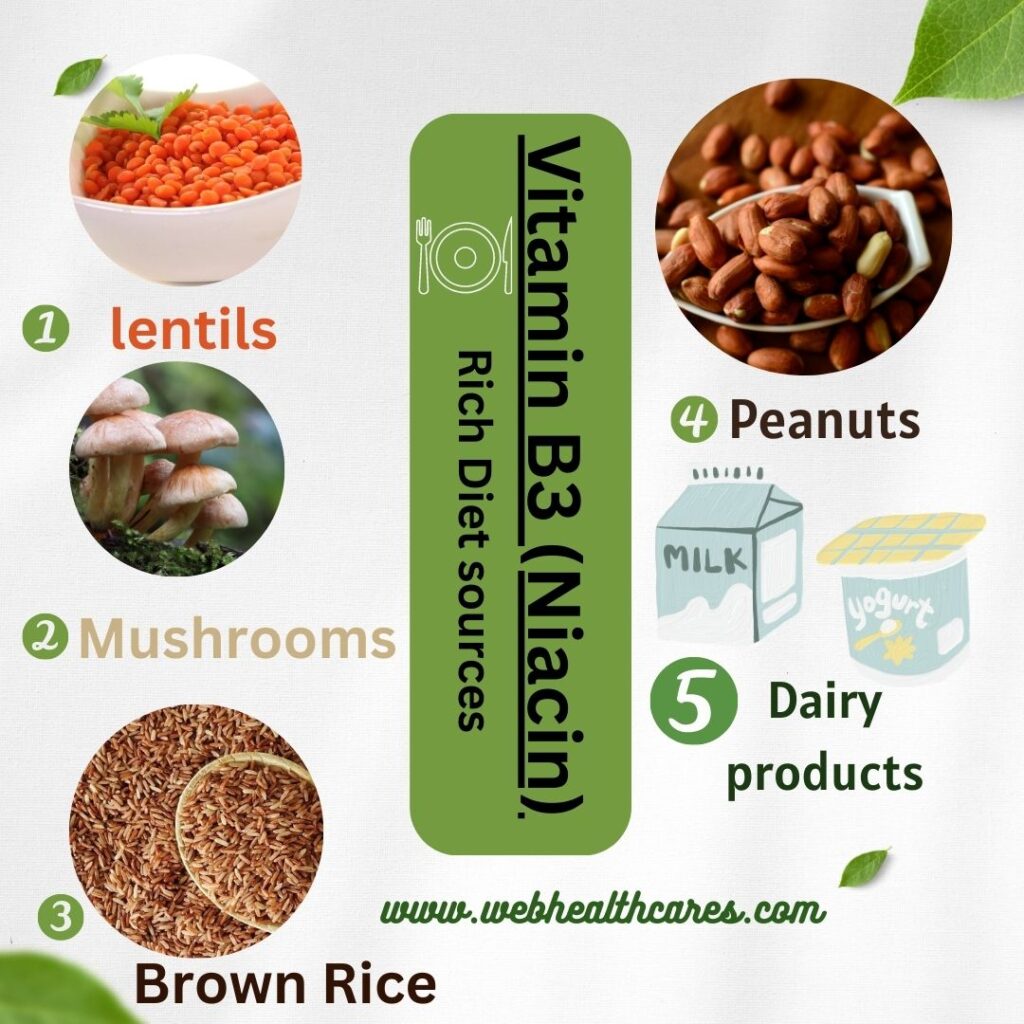- Vitamin B3, also known as Niacin or Nicotinic acid, is a water-soluble vitamin that important for energy metabolism, DNA repair, cell communication, and maintaining overall health and well-being.
- Niacin is available in two main forms: nicotinic acid and niacinamide. While both forms are utilized in the body, they differ in their effects.
- Nicotinic acid is beneficial in improving cholesterol levels, while niacinamide is primarily involved in cellular metabolism.
Benefits and function of Vitamin B3
- Energy production.
- Support Nervous system.
- Help lower levels of LDL (“bad”) cholesterol.
- Maintaining healthy skin by supporting the production of ceramides.
- Plays a role in DNA repair and supports the production and repair of cells
- Anti-inflammatory
- Support Mental health
Daily Requirement of Vitamin B3
The recommended dietary allowance (RDA) for vitamin B3 (niacin) is typically expressed in niacin equivalents (NE), NE for different age groups is as follows:
| Age Group | Male (mg/day) | Female (mg/day) |
|---|---|---|
| 0-6 months | 2* | 2* |
| 7-12 months | 4* | 4* |
| 1-3 years | 6 | 6 |
| 4-8 years | 8 | 8 |
| 9-13 years | 12 | 12 |
| 14-18 years | 16 | 14 |
| 19+ years | 16 | 14 |
| Pregnant | – | 18 |
| Breastfeeding | – | 17 |
Vitamin B3 Rich foods Sources
- Legumes:- Legumes, lentils, chickpeas, and black beans, are rich in dietary fiber, and protein and contain significant amounts of niacin. A cup of cooked lentils offers approximately 2.1 mg of niacin.
- Mushrooms:- Mushrooms, provide a decent amount of niacin. One cup of cooked portobello mushrooms contains approximately 3.6 mg of niacin.
- Whole Grains:- Whole grains like brown rice, barley, and oats are nutritious sources of niacin. These grains also offer dietary fiber, vitamins, and minerals.
- Seeds and Nuts:- Various seeds and nuts like almonds, cashews, and flaxseeds contribute to your daily niacin intake. Sunflower seeds, for instance, provide about 8.3 mg of niacin per 100 grams, while peanuts contain approximately 12 mg.
- Dairy Products:- Dairy products like milk, yogurt, and cheese also contain niacin. One cup of milk typically provides around 0.6 mg of niacin
- Vegetables:- Certain vegetables also contribute to your daily niacin intake. Mushrooms, avocados, peas, and asparagus are rich sources of vitamin B3.
- Chicken and Turkey: – Poultry, such as chicken and turkey, is an excellent source of niacin. Skinless chicken breast provides about 13.7 mg of niacin per 100 grams.
- Fish and Seafood:- Many types of fish and seafood are rich in vitamin B3. Tuna, salmon, and sardines are particularly high in niacin content, containing approximately 8 to 10 mg of niacin per 100 grams.
https://webhealthcares.com/vitamin-b2riboflavin-about-benefits-symptoms-diets-daily-intake-deficiency-disorder/
Deficiency Disorder due to lack of Vitamin B3
Due to a lack of niacin (vitamin B3) nutritional deficiency disorder is Known as Pellagra.
- Pellagra symptoms :-Pellagra symptoms knows as “D3“.
- Dermatitis (skin inflammation).
- Diarrhea.
- Dementia.
- Pellagra treatment:-
- Treatment typically involves increasing niacin intake through dietary changes or supplements. Consultation with a doctor is essential to confirm the diagnosis and appropriate treatment plan
Commonly questions asked about Vitamin B3 niacin-related
Q.1. Which disease is caused by deficiency of vitamin B?
Ans.- Deficiency of vitamin B3 disease called “pellagra.”
Q.2 What is the name of vitamin B3?
Ans.- Vitamin B3 is also known as Niacin or Nicotinic acid.
Q.3. Is it safe to take 500mg of niacin a day?
Ans.- It may be safe during some health conditions and deficiency of niacin. Always consult a doctor before taking niacin. 500mgusediacin is not safe for a healthy person.
Q.4. How long does niacin flush last?
Ans.- Niacin flush, temporary skin redness, and warmth, usually lasts about 30 minutes to an hour after taking niacin.
Q.5. Best time of day to take niacin?
Ans.- Recommended to take niacin after meals to reduce the risk of stomach upset.
Q.6. Does niacin help to lower cholesterol?
Ans.- Niacin can help lower cholesterol levels, but it should be taken under medical supervision due to potential side effects.
Q.7. Which type of niacin is best for lowering cholesterol?
Ans.- Extended-release niacin is often used to lower cholesterol levels effectively.
Q.8. What is flush-free niacin?
Ans.- “Flush-free” niacin usually refers to niacinamide, which doesn’t cause the flushing side effect but may not have the same cholesterol-lowering effects as regular niacin.
Q.9. Why take niacin at bedtime?
Ans.- Take niacin at bedtime to minimize the flushing side effects during waking hours.
Q.10. What is the difference between niacin and niacinamide?
Ans.- Niacin can cause flushing, while niacinamide does not. Both forms have different uses and benefits.
Q.11. How much vitamin B3 per day for glaucoma?
Ans.- No specific recommended daily intake of vitamin B3 for glaucoma. Consult your eye doctor for guidance on managing glaucoma.
Q.12. What is the difference between vitamin B3 and B12?
Ans.- B3 is essential for energy production and skin health, while B12 is important for nerve function and red blood cell formation.


This is my first time visit at here and i am truly pleassant
to read all at alone place.